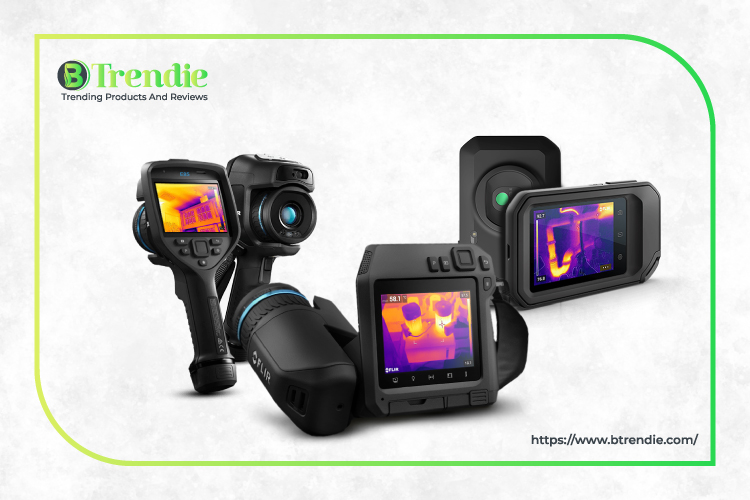Best Thermal cameras are powerful devices designed for three things – prevention, maintenance, and solution. These allow them to be used for industrial, commercial, medical, environmental, and safety purposes. Household owners and enthusiasts have also started to employ them for personal use.
The possibilities behind thermal imagers are truly endless. In this article, we’ll explore what you need to know before buying, including why you need a thermal camera, the benefits of owning one, and how to choose the best thermal camera. We’ve also included reviews of the best thermal cameras – from great deals to feature-packed options.
But before anything else, let us first understand the difference between a thermal and a regular camera.
Thermal Camera VS Ordinary Camera
Thermal Cameras
A thermal camera is no ordinary camera. It is a tool that “sees” images with the help of infrared radiation. A typical camera merely uses visible light from its surroundings to form images. So if there isn’t enough light or if the lens isn’t equipped with a good quality light sensor, a camera won’t be able to capture clear and detailed images or it won’t be able to pick up any image at all.
Specialized Imaging
Thermal cameras are different from regular cameras, even digital ones. In order to detect images, thermal imagers don’t rely on visible light – that is to say, light visible to the naked eye which is limited to 400-700 nanometers. Instead, a thermal camera “sees” its surroundings through infrared radiation, which occurs at wavelengths ranging from 9,000 to 14,000 nanometers.
Infrared is invisible to the naked eye. What the human eyes can’t see, a thermal or infrared camera can. This is where the need for a thermal camera becomes apparent.
Reasons You Need a Thermal Camera
- Prevention A thermal camera may be used as a preventive tool. It can detect problem areas in their early stages, which would have otherwise gone unnoticed in the absence of a thermal imager. With an infrared camera, you can accurately identify spots or specific areas that emit undesirable temperatures. Of course, this unwanted temperature varies depending on set guidelines. Through early detection, you can avoid dilemmas before they even happen and prevent problematic situations from getting worse.
- Maintenance A thermal imager may also be used for maintenance purposes. You can use it to monitor temperature levels on a regular basis. This helps ensure that temperatures are always within the normal range as prescribed.
- SolutionThe thermal camera is the answer to your problems. It has the ability to detect temperatures that are outside the desired range. This enables you to identify which specific problem is at hand, and how to resolve it.
The Benefits of Owning a Thermal Camera
The advantages of thermal cameras largely depend on what purpose they serve. Within industries and commercial environments, these innovative tools encourage efficiency among people and machinery. The information gathered by infrared cameras may also be used to develop plans that would improve operational management and cost savings. The promotion of health and personal safety in both public and private settings is another perk of thermal cameras that cannot be overlooked.
Some might consider infrared cameras to be a costly investment, with prices ranging from $1,000 to $8,000. But you must remember that the benefits of owning a thermal camera outweigh its cost on any given day, especially since it’s a long-term investment that lasts for years. Besides, there are many infrared cameras you could choose from depending on your budget and needs.
How to Choose the Best Thermal Camera
The choosing part is where it gets tricky since there are numerous thermal cameras on sale. That’s why we’ve made a list of five important things to consider before buying a thermal camera.
- Infrared (IR) resolution determines the maximum number of pixels an infrared sensor could capture. Thermal cameras have an IR resolution ranging from 0.005 to 0.08 megapixels. A higher-resolution model provides more thermographic information than a low-res alternative. You can expect better image quality from IR cameras that offer more detailed representations of an object or environment.
- Standard Resolution Many thermal imagers are equipped with a secondary digital camera that captures regular photos. These cameras have a standard resolution ranging from 0.3 to 3.1 megapixels. Together with the IR sensor – the primary mechanism behind thermographic imagers – these ordinary cameras help improve the overall quality of an image. Thus, a thermal camera with a low-res IR sensor can still give you decent images if it comes with a standard high-resolution camera.
- Focus Type Thermal cameras with fixed focus take photos within a limited range and are usually inexpensive. Models with adjustable focus either have manual or automatic focus (autofocus). Both types of adjustable focus give thermal cameras the ability to capture images outside the limited range of fixed-focus models. Infrared cameras with autofocus offer the most convenience. They spare you the hassle of manual adjustment that comes with manual focus.
- Precision The accuracy, sensitivity, and temperature range of a thermal camera determine its precision. The best thermal camera has the ability to identify temperatures as accurately as possible. Its readings should be close to or exactly the same as the actual temperature of an object or environment. A thermal camera must also have the capacity to distinguish slight temperature variations between different areas of an object and its environment – down to the last 0.05 degrees Celsius or less. A thermal camera with an extensive temperature range is preferable, though it really depends on what you need. Some people are content with a range of -20 to 250 degrees Celsius, while others require infrared cameras that could detect up to 1200 degrees Celsius.
- Battery Life and Charging Time When it comes to battery life, longer hours are better. It means that you can use a thermal camera for longer periods on the field. As for the charging time, shorter hours are preferred. In case your thermal camera runs out of juice, you should be able to charge it in the shortest time possible.
Other things to consider when buying a thermal camera include:
- Wi-Fi connectivity: For quick and easy downloading and transferring of captured images
- Radiometric video recording and streaming: For measuring and recording temperature and temperature changes in real-time
- Voice and text annotations: For taking useful notes regarding captured images and videos
- Laser pointers: For targeting specific spots when doing temperature readings
- Illuminator lamps: For additional lighting in low-light environments
Help and support:
The best thermal cameras include warranties from their manufacturers, who are willing to provide customer assistance whenever needed.
The Best Thermal Camera Reviews
You don’t want any thermal camera – you have to get the best. We compared the top thermal cameras of the year so you only get to choose what is best for you. The following reviews should make it easier for you to decide which thermal camera to buy.
| <strong>Image</strong> | <strong>Product</strong> | <strong>Dimension</strong> | <strong>Price</strong> |
|
Our Pick

|
FLIR E8 Review |
9.6 x 3.7 x 5.5 in |
|
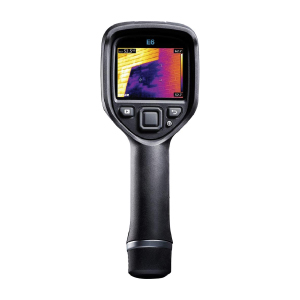
|
FLIR E6 Review |
|
|
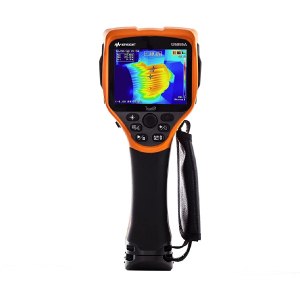
|
Keysight TrueIR Imager Review |
2.8 x 8.1 x 5.3 in |
|

|
FLIR E40 Review |
14 x 7.5 x 20 in |
|

|
Fluke Ti90 Review |
5.31 x 3.39 x 11.18 in |
Best Value for Your Money
Surprisingly affordable thermal cameras with enough features to cover your most basic needs
1. FLIR E8 Review
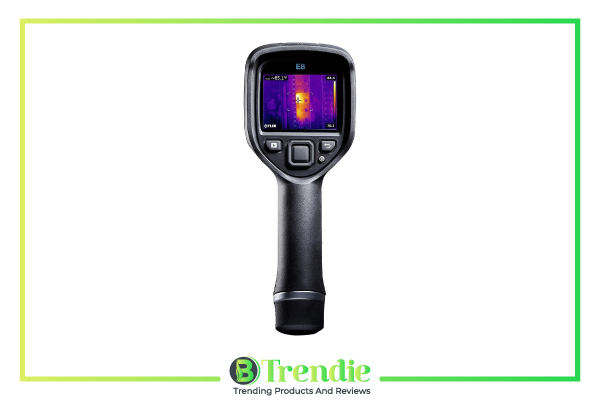
The FLIR E8 has the highest possible IR resolution found in thermal cameras. Its secondary camera pales in comparison with just 0.3MP, but who needs a 3.1MP option? The FLIR E8 is more than capable of delivering 320 x 240-pixel images, thank you very much – and with great thermal accuracy too!
The good news is you don’t have to spend so much on this high-res model. At $3,995, it isn’t the most expensive thermal camera on our list – that’s the FLIR E60. Even though it lacks Wi-Fi connectivity, voice annotations, and a touchscreen, the FLIR E8 is still one of the top thermal cameras offering value for your money. You get to have top image quality for a mid-range price.
2. FLIR E6 Review

The FLIR E6 is the next best thing to FLIR E8, but only if you are willing to settle for mid-range image quality. It has an IR resolution of 0.005MP and a secondary camera with a 2MP resolution that makes up for it. Both cameras allow E6 to capture 160 x 120-pixel images, the second-best image resolution among FLIR’s E-series.
This entry-level option is an affordable thermal camera at $2,495. Despite its lack of features and lower resolution, FLIR E6 is adequate for most applications.
3. Keysight TrueIR Imager Review

TrueIR Imager offers the same image resolution as the FLIR E6, but at a higher price. That’s because it has a few extra kinks under its sleeve, which makes $3,500 not that bad a price to pay. Keysight’s TrueIR thermal camera has an infrared sensor and standard camera with 0.02 and 3.1 megapixels respectively, capable of producing 160 x 120-pixel images.
It captures thermographic photos quite accurately and saves them in radiometric JPEG format, allowing you to open them using any photo viewer. However, you’d have to give up other cool features such as video capture, Wi-Fi connectivity, and annotations. Even then, Keysight TrueIR Imager is well-equipped for most thermal imaging needs.
4. FLIR E40 Review

The FLIR E40 sells for the same price as the TrueIR Imager. You also get the same camera sensors (0.02MP IR resolution, 3.1MP standard resolution), image quality (160 x 120 pixels), thermal accuracy, and radiometric JPEG formatting.
FLIR E40 does have several advantages over Keysight’s thermal imager. For starters, its radiometric JPEGs provide comprehensive data, especially when viewed using FLIR’s accompanying software. It’s also equipped with Wi-Fi connectivity and lets you easily share photos using the free app available for both iOS and Android users.
Unfortunately, E40 is limited to manual focus. While better than a fixed focus system, manual focus is prone to human error. A thermal camera’s ability to take detailed photos is therefore limited by the skills of its user. Moreover, manual focus requires time to adjust compared to an autofocus system which automatically adjusts itself.
5. Fluke Ti90 Review
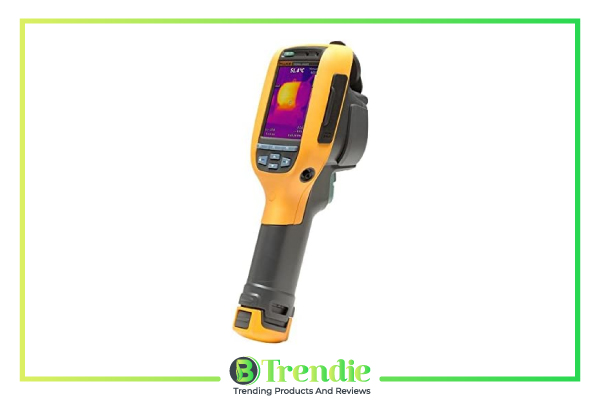
Ti90 is a decent option for those who don’t want to spend more than $1,500 on a thermal camera. It has built-in Wi-Fi connectivity for convenient file sharing – a feature that’s missing on pricier models like FLIR E6 and E8, or Keysight TrueIR Imager. It’s also capable of embedding captured photos with radiometric data to provide useful thermographic information. Fluke did make some compromises on the Ti90 to keep its affordable selling price.
Image quality isn’t a strong point for this entry-level model. Its infrared sensor only has 0.02MP while the standard camera has 0.3MP on it. This drags down image resolution to a meager 80 x 60 pixels, which is lower than the standards set by the Residential Energy Services Network (RESNET). The Ti90 also saves images in a proprietary IS2 format, which has limited compatibility with Fluke’s software and image viewers with IS2 readers.
It’s worth noting that in spite of a low-resolution camera, Ti90 has good thermal accuracy with less than a 2 percent margin of error. Combined with a low price and features you wouldn’t normally find in a cheap thermal camera, Fluke Ti90 is a bargain.
The Best Thermal Cameras
Fully-featured thermal imagers designed for professional use
6. FLIR E60 Review
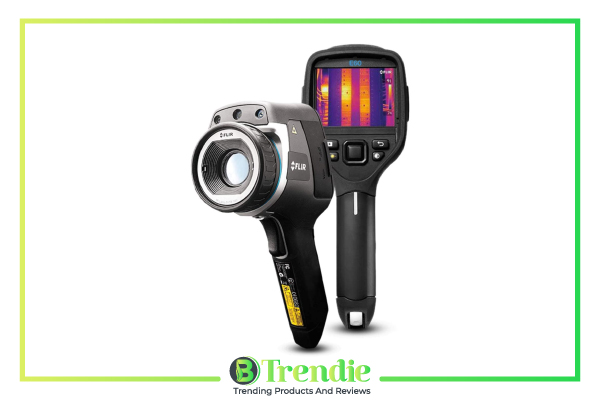
Packed with a 0.08MP IR sensor and 3.1MP standard sensor, this thermal camera means business. The E60 captures 320 x 240-pixel images – the best image quality for IR cameras. Captured images are saved in radiometric JPEG format which you can view on almost any platform. It provides the best thermal precision given its accurate readings, impressive sensitivity, and ability to discern from a wide range of temperatures.
Other features include Wi-Fi connectivity, voice and text annotations, and video capture. FLIR E60 also has a built-in illuminator lamp and the ability to record temperature changes in real-time. The free iOS and Android apps make it easier to share and organize files. With over 4 hours of use on a full battery, there’s almost nothing that the E60 doesn’t have.
There is one flaw with the FLIR E60, and that is a lack of autofocus. But with enough practice, you shouldn’t have trouble taking photos with its manual focus. This minor setback shouldn’t make you think it’s any less worth the investment. $8,000 is a reasonable price to pay for a professional-grade thermal camera.
7. Fluke Ti400 Review

Ti400 is equipped with a 5MP standard camera which takes better regular photos than the FLIR E60. However, it has the same 0.08MP infrared sensor and offers the same image quality of 320 x 240 pixels. One clear advantage it has over the E60 is a cheaper price. Fluke Ti400 sells for a little over $7,600 which is $400 less than the best thermal camera. The cost-cutting benefit of Ti400 does have its price. It only saves files in Fluke’s proprietary IS2 format like the Ti90.

